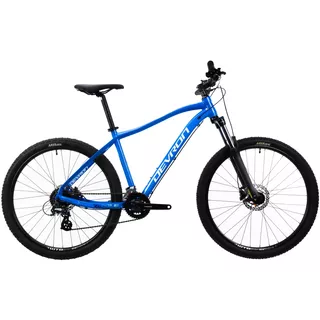Mountain Bike Devron Riddle H1.7 27.5” 1RM17 SALE
519,60 €
587,60 €

Compared products
2-year warranty
The Mountain Bike Devron Riddle H2.7 27.5” – 2.0 is a high quality mountain bike with top quality features and a lightweight Alu 6061 frame. The SUNTOUR XCM lockout front fork with 160mm travel, 27 gears, the lever gear shifter and Shimano components provide excellent riding characteristics. The high quality hydraulic disk brakes provide safety while the high Rubena R15 Cheetah tires can handle even the most challenging terrain. The design of the Mountain Bike Devron Riddle H2.7 27.5” makes it suitable for all cycling fans.
Our tips you might be interested in:
Technical description:
|
Frame |
Alu 6061 |
|
Fork |
SR Suntour XCR, Lockout, Rebound Adjust, 120mm |
|
Number of speeds |
27 |
|
Wheel size |
27.5" |
|
Gear shifter |
Shimano Altus SL-M370 Rapidfire Plus, lever |
|
Rear derailleur |
Shimano Acera RD-M3000-SGS |
|
Brakes |
Shimano Altus BR-M365 180/160 Hydraulic, disc |
|
Hubs |
Joytech |
|
Tires |
Rubena R15 Cheetah, 2.1" |
|
Rims |
WTB XS21 |
|
Cassette |
Shimano CS-HG300-9 (11-34) |
|
Chain |
KMC X9 |
|
Headset |
FSA, semi-integrated |
|
Seat |
DDK Speed Pro Race X5 |
|
Seatpost |
Zoom, 31.6mm |
|
Handlebars |
Zoom, Riser Bar, 680mm |
|
Grips |
ProPalm Custom |
|
Model |
2.0 |
Our tips:
| Frame | Al 6061 |
|---|---|
| Frame material | Aluminium |
| Brakes | Disc |
| Number of speeds | 27 |
| Suspension fork | yes |
| Fork | SR Suntour XCR, Lockout, Rebound Adjust, 120mm |
| Front Brake | Shimano Altus BR-M365 180mm |
| Wheel size | 27.5" (for users over 155 cm) |
| Rear Brake | Shimano Altus BR-M365 160mm |
| Rear hub | Joytech |
| Gear shifting type | lever |
| Front Hub | Joytech |
| Rear tire | Rubena R15 Cheetah, 2.1" |
| Front Tire | Rubena R15 Cheetah, 2.1" |
| Gear shifting | SHIMANO Altus SL-M370 Rapidfire Plus |
| Year | 2017 |
| Front derailleur | SHIMANO FD-M370 |
| Rear Derailleur | SHIMANO ACERA, RD-M3000-SGS |
| Crank Set | 22*32*44T/ ARM* 170-175mm |
| Cassette | SHIMANO CS-HG300-9 (11-34) |
| Chain | KMC X9 |
| Front Rim | WTB SX21 |
| Rear rim | WTB SX21 |
| Handlebar grip | Zoom, Riser Bar, 680 mm |
| Grips | ProPalm Custom |
| Head Tube | FSA, semi-integrated |
| Saddle | DDK Speed Pro Race X5 |
| Seat post | Zoom, 31,6mm |
We are sorry, but this product is no longer available.